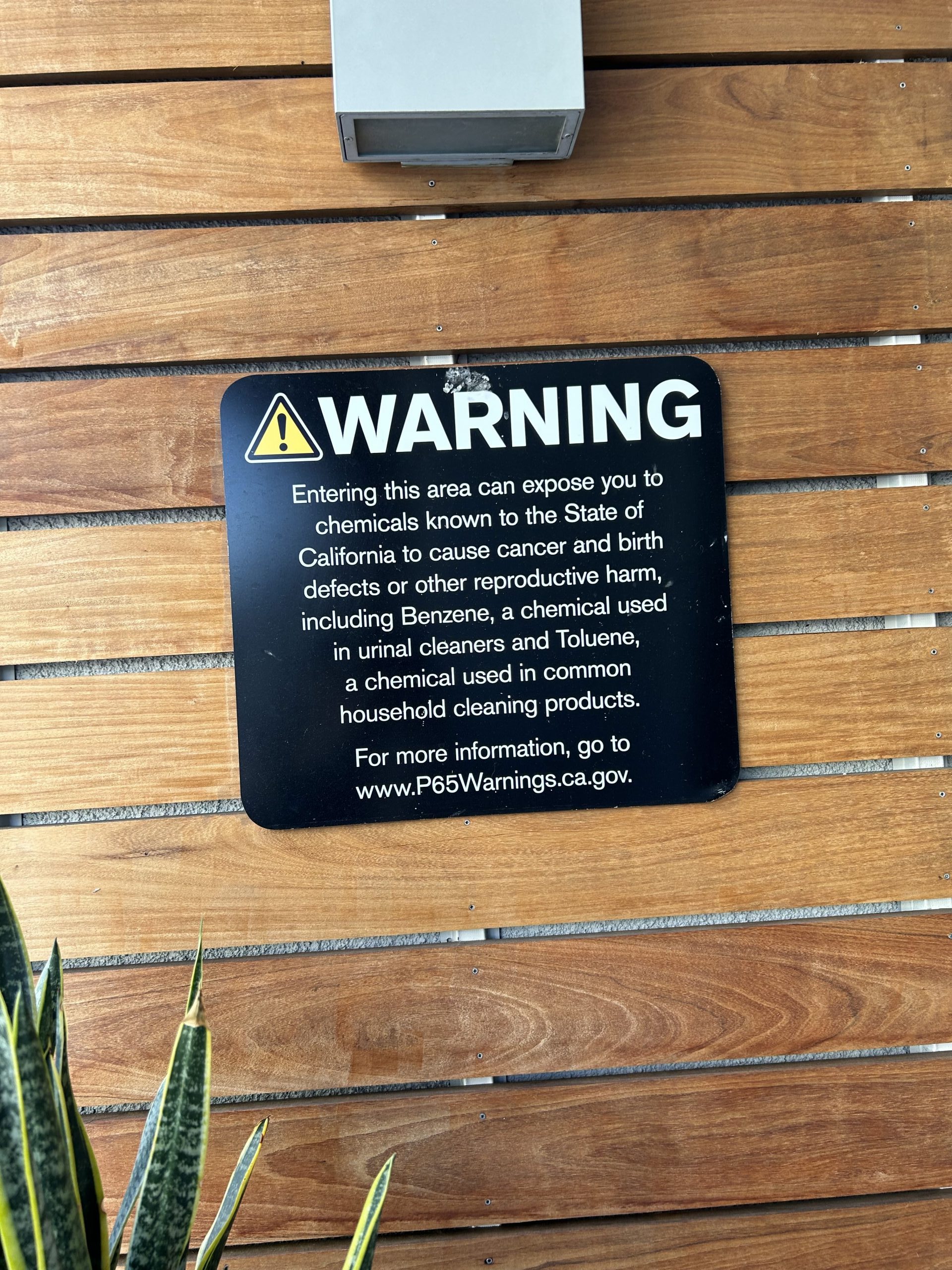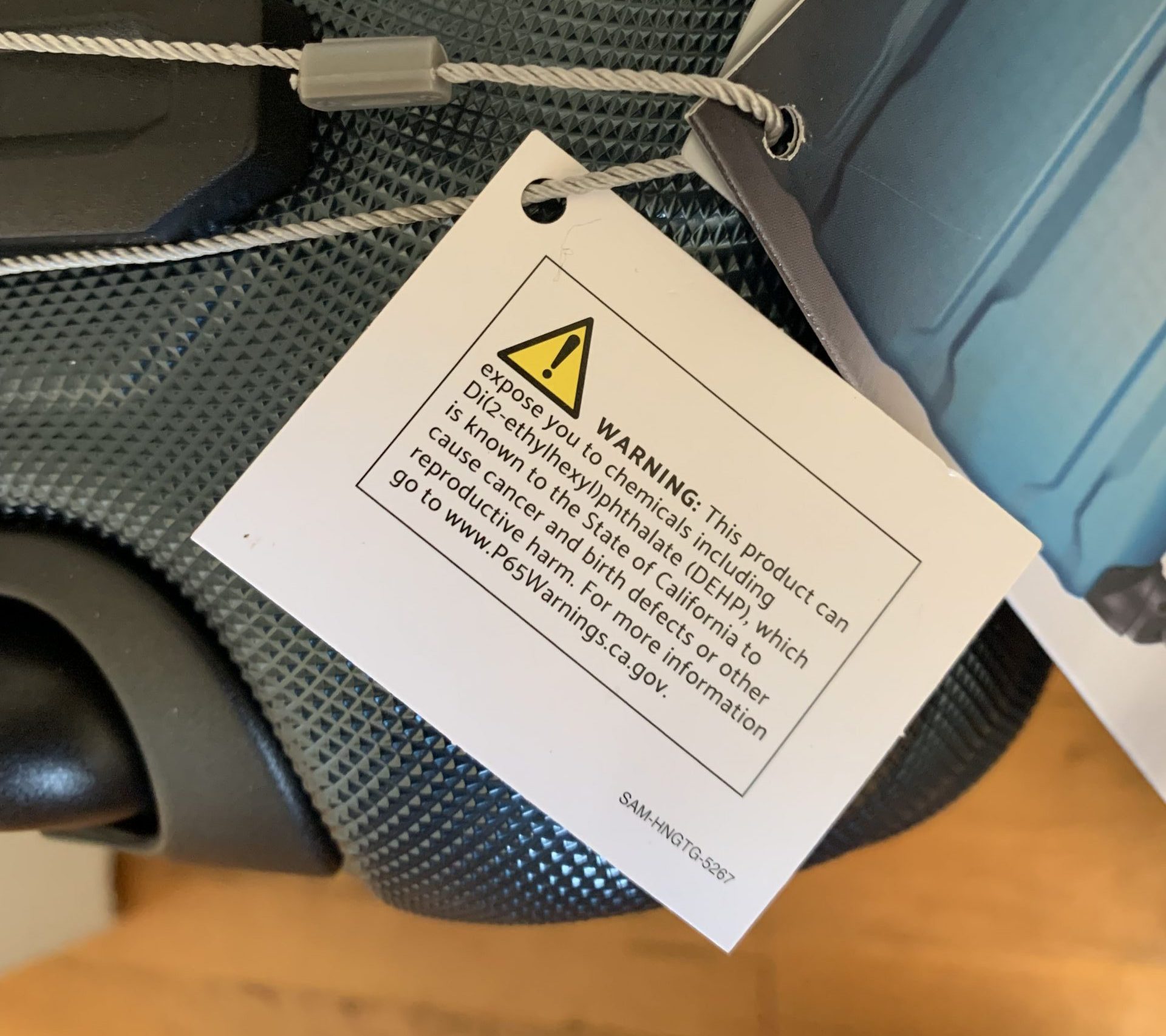WARNING: This Podcast Contains Chemicals Known to the State of California to Cause Cancer or Other Reproductive Harm – 99% Invisible
WARNING: This Podcast Contains Chemicals Known to the State of California to Cause Cancer or Other Reproductive ... 99% Invisible


Proposition 65: A Report on California’s Warning Labels
WARNING: Entering this area can expose you to chemicals known to the State of California to cause cancer and birth defects or other reproductive harm, including Benzene, a chemical used in urinal cleaners and Toluene, a chemical used in common household cleaning products. For more information, go to www.p65warnings.ca.gov.
Introduction
Intimidating Proposition 65 warnings like the one above can be found on various products manufactured or distributed in the State of California. These warnings are ubiquitous, appearing on everyday objects such as power tools, potato chips, dietary supplements, leather jackets, gas pumps, and coffee tables. This raises the question of whether these labels are truly effective in warning consumers of real dangers.
Propping Up Legislation

David Roe, a senior lawyer with the Environmental Defense Fund, wrote a ballot proposition called Proposition 65 in 1985. This proposition aimed to address the prevalent issue of hazardous air quality and toxic spills in Los Angeles, as well as the problem of lead in tap water. The proposition was intended to bridge the gap between existing laws regulating toxic chemicals and their actual enforcement.
The United States has struggled to effectively protect its citizens from toxic chemicals, with federal agencies like the FDA and the EPA failing to enforce regulations. In 1986, California was preparing for a gubernatorial election, and environmental groups saw an opportunity to address toxic chemical issues by proposing a ballot initiative. David Roe wrote Proposition 65, also known as the Safe Drinking Water and Toxic Enforcement Act of 1986, which required clear and reasonable warnings on products containing chemicals known to cause cancer or birth defects.
Implementation and Impact
Proposition 65 applied to all products in California and businesses distributing products into the state. The goal was to incentivize companies to avoid using toxic chemicals by requiring warning labels that could harm their reputation. The law did not ban these chemicals or impose penalties on businesses, but rather aimed to encourage self-regulation.

Proposition 65 faced opposition from big businesses seeking to avoid additional regulation, while environmental groups and celebrities supported the initiative. The proposition passed with overwhelming support.

Prop 65 in Practice
When Prop 65 went into effect, businesses initially attempted to circumvent the law by using vague warnings or signs in front of stores instead of labeling individual products. However, this intentional obfuscation was deemed illegal. The California Office of Environmental Health Hazard Assessment established a specific warning label:
WARNING: This product contains chemicals known to the State of California to cause cancer and birth defects or other reproductive harm.
In order to avoid these warning labels, many companies reformulated their products to eliminate toxic chemicals. However, some businesses faced lawsuits for violating Prop 65. Private individuals acting in the public interest could file lawsuits against companies failing to provide proper warnings. The burden of proof fell on the businesses being sued, and penalties could reach up to $2,500 per violation, per day.

Proposition 65 currently lists over 1000 chemicals, meaning many products contain these chemicals. Lawsuits related to Prop 65 have cost California businesses approximately $30 million annually, with a significant portion going towards attorney’s fees. Critics argue that the law has unintended consequences and encourages frivolous lawsuits.
Props to Prop 65

Supporters of Prop 65 argue that the warning labels are just one visible aspect of a larger system that has successfully prompted businesses to reformulate their products. This self-regulation benefits not only Californians but also consumers nationwide, as California’s economy influences global production standards.
Proposition 65 has led to significant changes in various industries, including the reduction of lead in drinking water pipes and the elimination of toxic chemicals from products such as water meters, wine bottle caps, and hand tools.

While there is room for improvement in the implementation and effectiveness of Prop 65, it remains the best solution available to address the risks associated with toxic chemicals in consumer products.
SDGs, Targets, and Indicators
-
SDG 3: Good Health and Well-being
- Target 3.9: By 2030, substantially reduce the number of deaths and illnesses from hazardous chemicals and air, water, and soil pollution and contamination.
- Indicator: Number of deaths and illnesses attributed to hazardous chemicals and pollution.
-
SDG 12: Responsible Consumption and Production
- Target 12.4: By 2020, achieve the environmentally sound management of chemicals and all wastes throughout their life cycle, in accordance with agreed international frameworks, and significantly reduce their release to air, water, and soil in order to minimize their adverse impacts on human health and the environment.
- Indicator: Number of companies implementing sustainable practices in chemical management and waste reduction.
Table: SDGs, Targets, and Indicators
| SDGs | Targets | Indicators |
|---|---|---|
| SDG 3: Good Health and Well-being | Target 3.9: By 2030, substantially reduce the number of deaths and illnesses from hazardous chemicals and air, water, and soil pollution and contamination. | Number of deaths and illnesses attributed to hazardous chemicals and pollution. |
| SDG 12: Responsible Consumption and Production | Target 12.4: By 2020, achieve the environmentally sound management of chemicals and all wastes throughout their life cycle, in accordance with agreed international frameworks, and significantly reduce their release to air, water, and soil in order to minimize their adverse impacts on human health and the environment. | Number of companies implementing sustainable practices in chemical management and waste reduction. |
Analysis
The issues highlighted in the article are connected to SDG 3: Good Health and Well-being and SDG 12: Responsible Consumption and Production.
SDG 3: Good Health and Well-being
The article discusses the presence of chemicals known to cause cancer and birth defects in various products. This is directly related to Target 3.9 of SDG 3, which aims to reduce the number of deaths and illnesses from hazardous chemicals and pollution. The warning labels mentioned in the article serve as a means to inform consumers about potential health risks associated with these chemicals.
SDG 12: Responsible Consumption and Production
The article highlights the need for businesses to reformulate their products to avoid using toxic chemicals in order to comply with Proposition 65. This aligns with Target 12.4 of SDG 12, which focuses on achieving environmentally sound management of chemicals and reducing their release to minimize adverse impacts on human health and the environment. The article also mentions the impact of Proposition 65 on encouraging companies to regulate themselves and make their products safer.
The indicators mentioned or implied in the article include the number of deaths and illnesses attributed to hazardous chemicals and pollution (Indicator for Target 3.9) and the number of companies implementing sustainable practices in chemical management and waste reduction (Indicator for Target 12.4).
Behold! This splendid article springs forth from the wellspring of knowledge, shaped by a wondrous proprietary AI technology that delved into a vast ocean of data, illuminating the path towards the Sustainable Development Goals. Remember that all rights are reserved by SDG Investors LLC, empowering us to champion progress together.
Source: 99percentinvisible.org

Join us, as fellow seekers of change, on a transformative journey at https://sdgtalks.ai/welcome, where you can become a member and actively contribute to shaping a brighter future.







